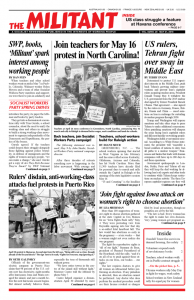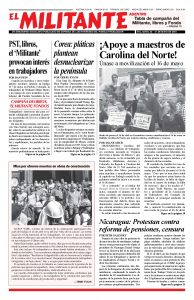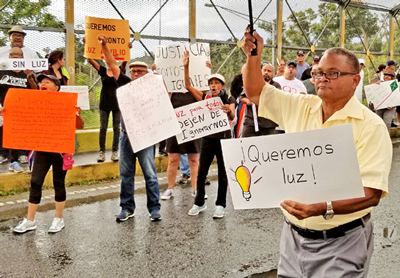Officials of the government-run electric company in Puerto Rico claim that 98 percent of the U.S. colony now has electricity, eight months after hurricanes Irma and Maria ravaged the island, and just a month before the next hurricane season begins. But almost nobody believes them, especially the tens of thousands still without power.
“We have entire towns in the center of the island still without light,” Marimer Castro told the Militant by phone May 7.
Castro helped organize a demonstration April 30 attended by more than 100 residents in Humacao and a May 7 evening torchlight march of hundreds there to demand electricity.
“It’s the first time I ever did anything like that,” Castro said. “It began as a conversation among neighbors.
“We went to the radio station and they interviewed us and broadcast the announcement for our meeting. The Catholic Church let us use a room,” she said. “So many people came that they didn’t fit. We decided to hold a march to the energy company offices.”
At the April 30 action one woman carried a bucket and washboard on her head, symbolizing the eight months they have had to wash clothes by hand. Another waved canned goods, because they can’t store fresh food. One carried a sign with the receipts for fueling her gas generator.
It’s not just the electricity, Castro said. “Water service is erratic. Wooden houses were totally destroyed, others lost their roofs. Yet the government is still just ‘evaluating’ the damages.
“There is no plan, it’s been a disaster,” she said. “We are still a colony. We depend on the U.S. but we don’t have the same conditions. There are pluses and minuses for statehood or for independence. But being in the middle, not one or the other, doesn’t work. We have to lose the fear that we can’t survive if we are independent and discuss it as an option.”
It is the U.S. capitalist rulers, not the hurricanes, that caused the crisis. Since U.S. troops wrested control of Puerto Rico from the Spanish government in 1898, Washington has plundered the natural resources and labor of the Puerto Rican people. The conditions of working people worsened in 2006, when the worldwide capitalist economic crisis began battering the island.
Scores of factories have shut down since then, while the debt to wealthy bondholders has mushroomed to at least $74 billion today.
To get the funds to pay on the debt, the colonial government has cut retirement benefits, increased sales taxes, laid off 30,000 public workers and closed more than 100 schools.
The public electric company also laid off workers, cut back on maintenance and halted any plans to improve the deteriorating power grid. Transmission towers were corroded, power plants covered in rust and spare parts in short supply. By the time the hurricanes hit, it was a disaster waiting to happen.
U.S.-based capitalist contractors have made a killing on contracts to repair the electrical grid. The New York Times reported May 6 that because of government red tape and poor coordination they often got paid for doing nothing. Lakeland Electric had a contract to work in Puerto Rico for 22 days, but its crew only carried out repairs for two and a half days. The bill — $820,271.
U.S.-imposed financial board
In August 2016 President Barack Obama signed a bipartisan bill that appointed the Financial Oversight and Management Board for Puerto Rico, known in Spanish as the junta, to take over the island’s finances and ensure payment on the debt.
In late April, the junta released its own labor “reform” bill, which it insisted be voted on by the Puerto Rican Senate. If approved it would cut the number of paid vacation and sick days in half and eliminate laws that prevent bosses from firing workers without cause.
“It’s a control board,” said Luis Epardo, a retired electrician in Aguadilla. “We’ll never get ahead until we stop hoping that the Americans are going to get us out this mess.”
On May 1 tens of thousands marched in San Juan, including large union and student contingents, to protest the anti-working-class measures. Many workplaces, especially in the capital and other large cities, were shut down for the day.
One march of thousands went to the Capitol and then continued on to La Fortaleza, the residence of Gov. Ricardo Rosselló. A second protest, with five feeder marches, converged on the Milla de Oro commercial and banking center.
Protesters carried signs against the planned shutdown of nearly 300 public schools, deeper cuts to pensions, the junta’s proposed labor “reform” and the transfer of hundreds of workers incarcerated in Puerto Rico to prisons in the United States.
Cops and SWAT teams used the excuse that a small group in one of the feeder marches were wearing masks and might become violent to stop it from getting to the rally site. As the protest was winding down the cops attacked with tear gas, pepper spray, rubber bullets and billy clubs.
“The cops attacked everyone, young and old, there were pregnant woman, too,” said Lenna Ramírez, a student at the University of Puerto Rico and a leader of the Hostosiano Youth, a pro-independence organization.


